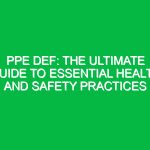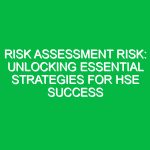Introduction
In the realm of Health, Safety, and Environment (HSE), risk assessment serves as a pivotal foundation for fostering a safe workplace and protecting the environment. Essentially, risk assessment is a systematic approach to identifying, evaluating, and prioritizing potential hazards and risks that could lead to accidents, injuries, or environmental harm. It empowers organizations to implement effective controls and mitigate adverse outcomes, ensuring compliance with legal standards and promoting a culture of safety.
Imagine walking into a manufacturing facility where safety protocols are not just a formality but a way of life. Employees wear protective gear, procedures are in place to handle hazardous materials, and the air is free from harmful pollutants. This scenario isn’t merely a dream; it is the result of diligent risk assessment practices. In this article, we will unravel the essential strategies of risk assessment within the HSE context, providing insights and practical approaches to enhance safety and sustainability.
Understanding Risk Assessment in the HSE Context
At its core, risk assessment involves several critical steps: hazard identification, risk analysis, risk evaluation, and risk control. Each step plays a vital role in shaping a comprehensive risk management strategy. Let’s explore these components in detail.
1. Hazard Identification
The first step in risk assessment is to identify potential hazards that could cause harm. Hazards can be physical, chemical, biological, ergonomic, or psychosocial. For instance, in a construction site, physical hazards may include falling objects, while chemical hazards could stem from exposure to toxic substances.
To effectively identify hazards, organizations can conduct site inspections, review incident reports, and engage employees in discussions about their experiences. In one notable case, a manufacturing plant discovered that a lack of proper ventilation led to the accumulation of harmful gases, prompting immediate changes to their systems.
2. Risk Analysis
Once hazards are identified, the next step is to analyze the associated risks. This involves evaluating the likelihood of an incident occurring and the potential severity of its consequences. Risk analysis can employ qualitative methods, such as expert judgment, or quantitative methods, such as statistical models.
For example, consider a chemical processing facility that handles flammable materials. Through risk analysis, the facility might determine that the likelihood of a fire is moderate, but the potential consequences could be catastrophic. Such insights drive the urgency for implementing stringent safety measures.
3. Risk Evaluation
Risk evaluation involves comparing estimated risks against predetermined criteria to determine their acceptability. This step helps organizations prioritize risks that require immediate attention. For instance, a construction firm may find that risks associated with working at heights are unacceptable and require immediate action, whereas risks from minor slips and trips may be deemed acceptable under controlled conditions.
4. Risk Control
The final step in risk assessment is to implement risk control measures. These measures can include eliminating the hazard, substituting it with a less dangerous option, engineering controls, administrative controls, and personal protective equipment (PPE). The hierarchy of controls is a guiding principle that helps organizations choose the most effective strategies.
Consider a factory that has identified noise exposure as a significant hazard. They may choose to implement engineering controls by installing sound barriers, use administrative controls by rotating workers through different tasks, and provide PPE like earplugs. Each of these actions contributes to a safer working environment.
Benefits of Effective Risk Assessment
Effective risk assessment not only safeguards employees and the environment but also contributes to organizational efficiency and reputation. Here are some key benefits:
- Enhanced Safety: By identifying and mitigating risks, organizations can significantly reduce the likelihood of accidents and injuries.
- Regulatory Compliance: Adhering to legal requirements related to health, safety, and environmental standards is crucial. Effective risk assessment helps ensure compliance, avoiding potential fines and legal issues.
- Increased Productivity: A safe work environment boosts employee morale and productivity. When workers feel safe, they are more likely to perform at their best.
- Cost Savings: Preventing accidents and incidents can lead to substantial cost savings in terms of medical expenses, insurance premiums, and potential litigation.
- Improved Reputation: Organizations known for prioritizing safety and environmental stewardship enhance their reputation, attracting clients and talent alike.
Best Practices for Conducting Risk Assessments
To maximize the effectiveness of risk assessments, organizations should adhere to several best practices:
- Involve Employees: Engage employees in the risk assessment process. Their firsthand experiences and insights can provide valuable information about potential hazards.
- Regular Reviews: Risk assessments should not be a one-time effort. Regularly review and update assessments to reflect changes in operations, regulations, or technology.
- Document Everything: Maintain thorough documentation of all risk assessments, including methodologies, findings, and control measures. This documentation serves as a reference and evidence of compliance.
- Training and Education: Provide ongoing training to employees on risk assessment processes, hazard recognition, and safety protocols. An informed workforce is a safer workforce.
- Utilize Technology: Leverage technology and software tools to streamline the risk assessment process, making it more efficient and effective.
Regulations and Standards Governing Risk Assessment
Numerous regulations and standards guide risk assessment practices within the HSE context. Understanding these requirements is essential for compliance and ensuring a safe working environment.
In the United States, the Occupational Safety and Health Administration (OSHA) mandates that employers provide a safe workplace. This includes conducting risk assessments to identify hazards and implement control measures. Similarly, the Environmental Protection Agency (EPA) sets regulations that require organizations to assess risks associated with environmental impacts.
Internationally, the ISO 45001 standard for occupational health and safety management systems emphasizes the importance of risk assessment. It provides a framework for organizations to identify and manage risks, ensuring a proactive approach to safety and health.
Case Studies: Real-Life Applications of Risk Assessment
To solidify the importance of risk assessment, let’s look at a couple of real-life case studies that highlight its impact.
Case Study 1: Chemical Plant Incident
A major chemical manufacturing plant experienced a significant incident due to a failure in risk assessment. The facility had not adequately identified the risks associated with chemical storage, leading to a massive explosion that resulted in injuries and extensive property damage. Following the incident, the company revamped its risk assessment practices, involving employees in hazard identification and implementing more robust safety measures. As a result, they significantly reduced incidents and improved overall safety performance.
Case Study 2: Construction Site Safety
On a construction site, a proactive risk assessment identified potential fall hazards before work commenced. The site managers implemented a comprehensive fall protection plan, including guardrails, safety nets, and personal fall arrest systems. This foresight not only prevented accidents but also fostered a culture of safety among the workers, demonstrating the effectiveness of thorough risk assessment in high-risk industries.
Conclusion
Risk assessment stands as a cornerstone in achieving a safer HSE environment. By systematically identifying and managing risks, organizations can protect their employees, comply with legal standards, and promote environmental sustainability. The benefits of effective risk assessment extend beyond safety; they influence productivity, cost savings, and reputation.
As industries continue to evolve, so too must our approaches to risk assessment. By embracing best practices, engaging employees, and adhering to regulatory standards, organizations can cultivate a culture of safety and responsibility. In a world where the stakes are high, investing in risk assessment is not just a necessity; it is a commitment to the well-being of employees and the environment. As you reflect on your own organizational practices, consider how you can enhance your risk assessment strategies for a safer, more sustainable future.


